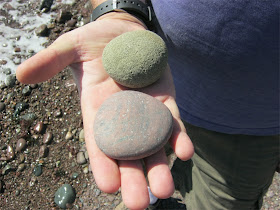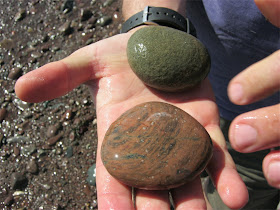Anyone who's looked at the various coffee table books on Japanese architecture and seen pictures of fine Japanese residences and their gardens will undoubtedly have come across pictures in a similar vein to this:
Another, here a typical detail shot showing a pathway:
What's interesting to a western observer, I suspect, is that the pathway looks freshly washed. In picture after picture showing the entry path to the house and its laid down stone path, in a diversity of shiki-ishi patterns. At first one might conclude some sort of coincidence that the pictures were taken after a rain shower, however blue skies in the background and the persistence of the freshly-washed look leads to the conclusion that somethign else is going on here.
It is customary for the owner of a traditional house and garden, katei, to wash the approach path to the door whenever guests are expected. Is this because the path is otherwise filthy? No. Is this because the Japanese are culturally more obsessed with washing everything down than other cultures. Well, that might be part of it. Is it because the Japanese are devout believers in Shintōisn and the cult of purity has washed down, so to speak, even to the level of scrubbing the path all the time? No.
While it is obviously true that carefully washing a path prior to a visit by a guest shows esteem on the part of the house owner towards their guest, a desire to 'put them on a pedestal' so to speak, there is something else going on here.
To explain, here's a couple of stones my wife and I picked up on a beach this summer during a trip to the Bay of Fundy region of New Brunswick:
Pretty mundane looking, until you splash some water on them:
Here's a section of otherwise ordinary looking rocks just washed by the tide, revealing a delightful panoply of riotous color:
So, what's really interesting, in my view about the Japanese residence and its stone pathway, is the hidden beauty aspect. The transient beauty aspect. These are key pieces of the puzzle that is the Japanese view on beauty in general in fact. To think that such things are hidden in plain sight!
The ordinary can be magical in the right moment, even if only for a moment. And it's something you wouldn't likely notice if you weren't paying attention or were expecting. I love how Japanese architecture plays so strongly to the senses, appealing to the eye and touch so well, reveling in the diffuse light through the shōji, leaving the messages of craftsmanship and subtlety there to be found if one can be centered and observant and inquisitive. I think it is a lesson for those outside of that culture to pick up on and see if we might find resonance with such ideas and such ways of appreciating of showing these ever-so-humble natural building materials.
Thanks for visiting the Carpentry Way.





Chris,
ReplyDeleteAn interesting post. The small duties to create a pleasing atmosphere become even more acute when the tea ceremony is the subject of attention. I have a friend that is a gardner, and his wife teaches the tea ceremony. They have a beautiful traditionally designed home, and a magnificent garden, and inside the house and sticking out into a small corner of the garden, is a special four mat room, designed and built for the ceremony. It is a lovely room where the choice of materials and carpentry details provide interest and serenity. I have visited them many times, it is always a delight to go over there, but the few times I have been invited to participate in the ceremony, although being rather incapable myself, it is a special occasion that they somehow create via attention to small things, including the watered paths.
I used to see people sweeping the paths in front of their homes early every morning, usually elderly women, but it seems to seldom get done with such regularity any more. Still, it might be more prevalent at some locations where the spirit of old survives. Little things like that add comfort and reason in an also subliminal kind of way.
Dennis,
ReplyDeletethanks for sharing that. I also have fond memories of attending tea ceremonies and spending time in spaces which encourage a contemplative state.
~C